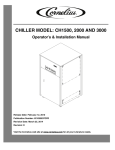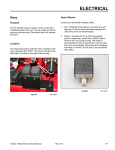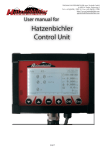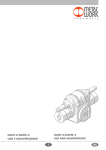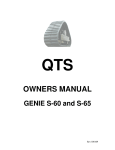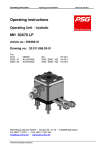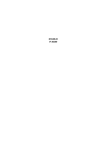Download Cornelius CH3000 Installation manual
Transcript
CHILLER Model CH3000 Operator’s & Installation Manual Release Date: February 14, 2011 Publication Number: 620054173OPR Revision Date: May 08, 2014 Revision: B Visit the Cornelius web site at www.cornelius.com for all your Literature needs. The products, technical information, and instructions contained in this manual are subject to change without notice. These instructions are not intended to cover all details or variations of the equipment, nor to provide for every possible contingency in the installation, operation or maintenance of this equipment. This manual assumes that the person(s) working on the equipment have been trained and are skilled in working with electrical, plumbing, pneumatic, and mechanical equipment. It is assumed that appropriate safety precautions are taken and that all local safety and construction requirements are being met, in addition to the information contained in this manual. This Product is warranted only as provided in Cornelius’ Commercial Warrant applicable to this Product and is subject to all of the restrictions and limitations contained in the Commercial Warranty. Cornelius will not be responsible for any repair, replacement or other service required by or loss or damage resulting from any of the following occurrences, including but not limited to, (1) other than normal and proper use and normal service conditions with respect to the Product, (2) improper voltage, (3) inadequate wiring, (4) abuse, (5) accident, (6) alteration, (7) misuse, (8) neglect, (9) unauthorized repair or the failure to utilize suitably qualified and trained persons to perform service and/or repair of the Product, (10) improper cleaning, (11) failure to follow installation, operating, cleaning or maintenance instructions, (12) use of “non-authorized” parts (i.e., parts that are not 100% compatible with the Product) which use voids the entire warranty, (13) Product parts in contact with water or the product dispensed which are adversely impacted by changes in liquid scale or chemical composition. Contact Information: To inquire about current revisions of this and other documentation or for assistance with any Cornelius product contact: www.cornelius.com 800-238-3600 Trademarks and Copyrights: This document contains proprietary information and it may not be reproduced in any way without permission from Cornelius. Printed in U.S.A. TABLE OF CONTENTS Safety Instructions. . . . . . . . . . . . . . . . . . . . . . . . . . . . . . . . . . . . . . . . . . . . . . . . . . . . . . . . . . . . . . . . . 1 Read and Follow ALL Safety Instructions . . . . . . . . . . . . . . . . . . . . . . . . . . . . . . . . . . . . . . . . . . . . . 1 Safety Overview . . . . . . . . . . . . . . . . . . . . . . . . . . . . . . . . . . . . . . . . . . . . . . . . . . . . . . . . . . . . . . 1 Recognition . . . . . . . . . . . . . . . . . . . . . . . . . . . . . . . . . . . . . . . . . . . . . . . . . . . . . . . . . . . . . . . . . 1 Different Types of Alerts . . . . . . . . . . . . . . . . . . . . . . . . . . . . . . . . . . . . . . . . . . . . . . . . . . . . . . . . . . 1 Safety Tips . . . . . . . . . . . . . . . . . . . . . . . . . . . . . . . . . . . . . . . . . . . . . . . . . . . . . . . . . . . . . . . . . . . . . 1 Qualified Service Personnel. . . . . . . . . . . . . . . . . . . . . . . . . . . . . . . . . . . . . . . . . . . . . . . . . . . . . . . . 1 Safety Precautions. . . . . . . . . . . . . . . . . . . . . . . . . . . . . . . . . . . . . . . . . . . . . . . . . . . . . . . . . . . . . . . 2 Shipping And Storage . . . . . . . . . . . . . . . . . . . . . . . . . . . . . . . . . . . . . . . . . . . . . . . . . . . . . . . . . . . . 2 General Information. . . . . . . . . . . . . . . . . . . . . . . . . . . . . . . . . . . . . . . . . . . . . . . . . . . . . . . . . . . . . . . . 3 Introduction . . . . . . . . . . . . . . . . . . . . . . . . . . . . . . . . . . . . . . . . . . . . . . . . . . . . . . . . . . . . . . . . . . . . 3 Specifications . . . . . . . . . . . . . . . . . . . . . . . . . . . . . . . . . . . . . . . . . . . . . . . . . . . . . . . . . . . . . . . . 3 Specification Notes . . . . . . . . . . . . . . . . . . . . . . . . . . . . . . . . . . . . . . . . . . . . . . . . . . . . . . . . . . . 3 Location . . . . . . . . . . . . . . . . . . . . . . . . . . . . . . . . . . . . . . . . . . . . . . . . . . . . . . . . . . . . . . . . . . . . . . . 3 Electrical . . . . . . . . . . . . . . . . . . . . . . . . . . . . . . . . . . . . . . . . . . . . . . . . . . . . . . . . . . . . . . . . . . . . . . 4 Plumbing . . . . . . . . . . . . . . . . . . . . . . . . . . . . . . . . . . . . . . . . . . . . . . . . . . . . . . . . . . . . . . . . . . . . . . 4 Chiller with Reservoir . . . . . . . . . . . . . . . . . . . . . . . . . . . . . . . . . . . . . . . . . . . . . . . . . . . . . . . . . . 5 Chiller without Reservoir . . . . . . . . . . . . . . . . . . . . . . . . . . . . . . . . . . . . . . . . . . . . . . . . . . . . . . . 5 Start up . . . . . . . . . . . . . . . . . . . . . . . . . . . . . . . . . . . . . . . . . . . . . . . . . . . . . . . . . . . . . . . . . . . . . . . . . . 6 Water Flow Start Up. . . . . . . . . . . . . . . . . . . . . . . . . . . . . . . . . . . . . . . . . . . . . . . . . . . . . . . . . . . . . . 6 Chiller with Pump . . . . . . . . . . . . . . . . . . . . . . . . . . . . . . . . . . . . . . . . . . . . . . . . . . . . . . . . . . . . . 6 Chiller without Pump . . . . . . . . . . . . . . . . . . . . . . . . . . . . . . . . . . . . . . . . . . . . . . . . . . . . . . . . . . 6 Thermostat. . . . . . . . . . . . . . . . . . . . . . . . . . . . . . . . . . . . . . . . . . . . . . . . . . . . . . . . . . . . . . . . . . . . . 6 (Temperature Controller) . . . . . . . . . . . . . . . . . . . . . . . . . . . . . . . . . . . . . . . . . . . . . . . . . . . . . . . 6 Standard Thermostat Eliwell IC902 . . . . . . . . . . . . . . . . . . . . . . . . . . . . . . . . . . . . . . . . . . . . 6 Cooling Start Up. . . . . . . . . . . . . . . . . . . . . . . . . . . . . . . . . . . . . . . . . . . . . . . . . . . . . . . . . . . . . . . . . 7 Control Panel . . . . . . . . . . . . . . . . . . . . . . . . . . . . . . . . . . . . . . . . . . . . . . . . . . . . . . . . . . . . . . . . . . . 7 Maintenance . . . . . . . . . . . . . . . . . . . . . . . . . . . . . . . . . . . . . . . . . . . . . . . . . . . . . . . . . . . . . . . . . . . . . . 8 Fluid Recommendation . . . . . . . . . . . . . . . . . . . . . . . . . . . . . . . . . . . . . . . . . . . . . . . . . . . . . . . . . . . 8 Troubleshooting. . . . . . . . . . . . . . . . . . . . . . . . . . . . . . . . . . . . . . . . . . . . . . . . . . . . . . . . . . . . . . . . . . . 9 Service . . . . . . . . . . . . . . . . . . . . . . . . . . . . . . . . . . . . . . . . . . . . . . . . . . . . . . . . . . . . . . . . . . . . . . . . . 10 Safety Controls . . . . . . . . . . . . . . . . . . . . . . . . . . . . . . . . . . . . . . . . . . . . . . . . . . . . . . . . . . . . . . . . 10 Hi Pressure Control (HPC). . . . . . . . . . . . . . . . . . . . . . . . . . . . . . . . . . . . . . . . . . . . . . . . . . . . . 10 Low Temperature Control (LTC) . . . . . . . . . . . . . . . . . . . . . . . . . . . . . . . . . . . . . . . . . . . . . . . . 10 Low Pressure Control (LPC) . . . . . . . . . . . . . . . . . . . . . . . . . . . . . . . . . . . . . . . . . . . . . . . . . . . 11 Wiring Diagram . . . . . . . . . . . . . . . . . . . . . . . . . . . . . . . . . . . . . . . . . . . . . . . . . . . . . . . . . . . . . . . . 15 CH3000 Chiller Operator’s & Installation Manual SAFETY INSTRUCTIONS READ AND FOLLOW ALL SAFETY INSTRUCTIONS Safety Overview • Read and follow ALL SAFETY INSTRUCTIONS in this manual and any warning/caution labels on the unit (decals, labels or laminated cards). • Read and understand ALL applicable OSHA (Occupational Safety and Health Administration) safety regulations before operating this unit. Recognition Recognize Safety Alerts ! This is the safety alert symbol. When you see it in this manual or on the unit, be alert to the potential of personal injury or damage to the unit. DIFFERENT TYPES OF ALERTS ! DANGER: Indicates an immediate hazardous situation which if not avoided WILL result in serious injury, death or equipment damage. ! WARNING: Indicates a potentially hazardous situation which, if not avoided, COULD result in serious injury, death, or equipment damage. ! CAUTION: Indicates a potentially hazardous situation which, if not avoided, MAY result in minor or moderate injury or equipment damage. SAFETY TIPS • Carefully read and follow all safety messages in this manual and safety signs on the unit. • Keep safety signs in good condition and replace missing or damaged items. • Learn how to operate the unit and how to use the controls properly. • Do not let anyone operate the unit without proper training. This appliance is not intended for use by very young children or infirm persons without supervision. Young children should be supervised to ensure that they do not play with the appliance. • Keep your unit in proper working condition and do not allow unauthorized modifications to the unit. QUALIFIED SERVICE PERSONNEL ! WARNING: Only trained and certified electrical, plumbing and refrigeration technicians should service this unit. ALL WIRING AND PLUMBING MUST CONFORM TO NATIONAL AND LOCAL CODES. FAILURE TO COMPLY COULD RESULT IN SERIOUS INJURY, DEATH OR EQUIPMENT DAMAGE. © 2011-2014, Cornelius Inc. -1- Publication Number: 620054173OPR CH3000 Chiller Operator’s & Installation Manual SAFETY PRECAUTIONS This unit has been specifically designed to provide protection against personal injury. To ensure continued protection observe the following: ! WARNING: Disconnect power to the unit before servicing following all lock out/tag out procedures established by the user. Verify all of the power is off to the unit before any work is performed. Failure to disconnect the power could result in serious injury, death or equipment damage. ! CAUTION: Always be sure to keep area around the unit clean and free of clutter. Failure to keep this area clean may result in injury or equipment damage. SHIPPING AND STORAGE ! CAUTION: Before shipping, storing, or relocating the unit, the unit must be sanitized and all sanitizing solution must be drained from the system. A freezing ambient environment will cause residual sanitizing solution or water remaining inside the unit to freeze resulting in damage to internal components. Publication Number: 620054173OPR -2- © 2011-2014, Cornelius Inc. CH3000 Chiller Operator’s & Installation Manual GENERAL INFORMATION INTRODUCTION Cornelius CH Series, Refrigerated Recirculating Water Chillers are designed to provide a continuous flow of clean cooling water at a constant temperature and to handle a variety of closed loop and tank cooling applications. The CH Series consists of a refrigeration system with associated operating controls housed in a sturdy sheet metal cabinet. A standard pump and reservoir package provides a complete self-contained water cooling and circulating system. CH Series Chillers are designed to operate in a clean laboratory or industrial environment where ambient temperatures range from 50°F to 100°F. Once properly installed, CH Series Chillers run virtually maintenance free and provide a constant supply of cooling liquid to the application. Specifications The CH Series specifications are shown in Table 1. Table 1. Model CH3000 Cooling capacity, Watts/BTU/hr 10550/36000 Compressor 3 HP Condenser Air Cooled Temperature Controller Digital Display 40o -100o F Pump Many Available Reservoir (Capacity) 10 Gallons Voltage (Full Load Amps) 460/60/3 (9) Dimensions W x D x H (inches) 28 x 28 x 41 Inlet/Outlet Fitting Size 3/4-inch Specification Notes 1. The figures for power and cooling capacity are listed for air-cooled units with a circulation temperature of 68° F and ambient temperature of 80°F and standard pump. 2. Cooling capacity will be affected as follows: Derate 17% for 50 Hz operation. Derate 1% for each ° F drop in recirculating temperature. Derate 0.5% for each ° F increase in ambient temperature. 3. The operating water temperature range for water is 50° F (10° C) to 100° F (38° C). If uses of other fluids or temperatures are required, the Technical Service Department must be contacted so the appropriate ranges can be set. 4. All CH Series Chillers are thoroughly tested before leaving the factory to ensure that each unit meets these specifications prior to shipment. LOCATION Install the Chiller indoors in a well ventilated area where ambient temperatures will never fall below 50° F or rise above 110° F. To obtain optimum cooling capacity, the ambient temperature should be 80° F or below. Standard CH Chillers have air-cooled condensers. On air-cooled units it is important that the air intake and discharge are not obstructed. Avoid hot air discharge from other equipment or enclosed areas where heat build-up could cause a significant rise in ambient temperatures. A minimum of two feet of space on all four sides of the Chiller will be sufficient to prevent obstruction. © 2011-2014, Cornelius Inc. -3- Publication Number: 620054173OPR CH3000 Chiller Operator’s & Installation Manual Figure 1. Installation Details ELECTRICAL All wiring must conform to the National Electric Code and any applicable local codes. The chiller must be PERMANENTLY wired by means of electrical conduit to a properly fused disconnect of proper amperage or wired to a properly rated power cord and plugged into an outlet with the appropriate disconnect and amperage rating. The electrical junction box located on the upper rear of the chiller, includes a four-terminal strip for power supply connections. The DATA PLATE, located beside the junction box, indicates the actual phase, voltage and amperage for each chiller. ! CAUTION: On 3-phase applications, it is important that the rotation of the pump, when supplied, is correct. Running the pump in reverse for more than a few seconds will result in permanent pump damage. When the pump is running, shaft rotation must match the direction indicated on the pump housing. If the rotation is incorrect, reverse two of the three incoming power supply leads. The Phase Protection/3-Phase Monitor Option prevents the pump from operating backwards. See the option description. PLUMBING ! WARNING: This equipment must be installed to comply with the International Plumbing Code of the International Code Council and the Food Code Manual 01 the Food and Drug Administration (FDA). For models installed outside the U.S.A., you must comply with the applicable Plumbing/Sanitation Code for your area. Publication Number: 620054173OPR -4- © 2011-2014, Cornelius Inc. CH3000 Chiller Operator’s & Installation Manual Failure to comply could result in serious in jury, death or damage to the equipment. Follow standard plumbing practices and local codes in making water connections. The chiller inlet and outlet connections are 3/4-inch. Flexible hoses and fittings are recommended for plumbing the system. A No. 20 mesh strainer should be installed on the chiller inlet to prevent foreign particles from entering the system and should be cleaned monthly (field installation, not provided with chiller). Lines should be routed with as few bends as possible. Prevent lines from running near radiators, hot water pipes, etc. Any lengths of tubing that are exposed to high ambient temperatures should be insulated to prevent condensation and/or significant liquid heat loss. Chiller with Reservoir The reservoir can be filled by removing the water fill cap located on the upper rear of the Chiller (See Fluid Recommendations). After ensuring that the drain valve is closed, fill the reservoir via the full port with clean water until the water level sight glass on the front of the unit indicates “FULL” the fill cap should then be reinstalled before operation begins. Chiller without Reservoir The chiller and system piping should be filled with clean water or proper fluid ensuring that all air is purged from the system. Figure 2. Chiller Plumbing Schematic with Pump and Tank (Standard) Figure 3. Chiller Plumbing Schematic, no Tank (Option) Figure 4. Chiller Plumbing Schematic, no Pump, no Tank (Option) © 2011-2014, Cornelius Inc. -5- Publication Number: 620054173OPR CH3000 Chiller Operator’s & Installation Manual START UP WATER FLOW START UP Chiller with Pump It is important to check the pump rotation on the three phase units. Remove the lower side panel to expose the pump. Turn the pump power switch to the “ON” position for a few seconds. Observe the motor shaft to ensure that it is turning in the direction indicated by the arrow located on the pump housing. If the rotation is incorrect, reverse two of the three incoming power supply leads at the terminal strip. After changing the leads, check the pump rotation again. NOTE: Running the pump in reverse for more than a few seconds will result in permanent pump damage. After ensuring that the system piping is free from obstruction and that all valves are open, turn the pump power switch to the “ON” position (press in). The pump power indicator should illuminate, indicating that the pump is operating. All chillers with pumps are provided with a pressure regulating valve on the pump discharge. This valve is preset at the factory to ensure that system pressure does not exceed the capabilities of the pump motor and/or piping. If this valve requires adjustment, please contact the factory for proper setting procedure and pressures. A flow meter and throttling valve can be added in the chiller inlet line in order to monitor and/or adjust the flow rate through the chiller. Once the flow has been established, the thermostat can be adjusted to the desired set-point. Chiller without Pump A flow meter and throttling valve can be added in the chiller inlet line in order to monitor and/or adjust the flow rate through the chiller. Once the flow has been established, the thermostat can be adjusted to the desired set-point. See thermostat adjustment. THERMOSTAT (Temperature Controller) Figure 5. Temperature Control Panel Standard Thermostat Eliwell IC902 The following procedure should be followed to adjust the Eliwell IC902 thermostat temperature setting: 1. To set the “SET POINT”, press and release the “SET” button, “set” will display. 2. Press the “set” button again, the current “SET POINT” will display. Press the “UP” or “DOWN” button to change the “SET POINT” to the desired temperature. 3. Press the “fnc” button twice to exit the program; the current liquid temperature will be displayed. The thermostat has a range that has been preset at the factory. The range is 40º F (5º C) to 100º F (38º C). If operation outside of this range is required, please contact the Technical Service Department. Publication Number: 620054173OPR -6- © 2011-2014, Cornelius Inc. CH3000 Chiller Operator’s & Installation Manual COOLING START UP Once flow is established and the thermostat is set to the desired set-point, turn the control power switch to “ON” (press in). All alarm indicators should be extinguished and the Chiller refrigeration system will cycle in order to maintain the established set-point. The refrigeration system is furnished with a Hot Gas Bypass system that maintains the set-point within 1º F temperature tolerance by cycling the Hot Gas Bypass Solenoid (Compressor, Fan Motor and Circulating pump run continuously). Re-check the reservoir level to ensure that it is “FULL” (if so equipped) and add water or proper fluid if necessary. The chiller is now ready for normal operation. Figure 6. CONTROL PANEL 1. TEMPERATURE INDICATOR/CONTROLLER (Thermostat) - Combines a precise temperature control and accurate set ability with a convenient LED temperature readout that indicates system liquid temperature. 2. CONTROL POWER SWITCH - A simple (Push Button) switch with light indicator that switches power to the control circuit (White). This switch must be “pressed in” for the Chiller to operate. 3. COOLING LIGHT - A green light that indicates refrigeration system operation. This light cycles on and off in response to the thermostat. 4. HIGH PRESSURE ALARM LIGHT - A red light that indicates high refrigeration pressure. 5. LOW PRESSURE ALARM LIGHT - A red light that indicates low refrigeration pressure. 6. LOW TEMPERATURE ALARM LIGHT - A red light that indicates and abnormally low system fluid temperature. 7. PUMP POWER SWITCH (OPTIONAL) - A simple (Push Button) switch with a light indicator that switches power to the chiller pump (White). This switch must be “pressed in” for the chiller to operate. © 2011-2014, Cornelius Inc. -7- Publication Number: 620054173OPR CH3000 Chiller Operator’s & Installation Manual MAINTENANCE ! WARNING: Disconnect power to the unit before servicing. Follow all lock out/tag out procedures established by the user. Verify all power is off to the unit before performing any work. Failure to comply could result in serious injury, death or damage to the equipment. ! WARNING: The chiller requires very little normal maintenance. 1. On air cooled chillers, the condenser fins should be cleaned by blowingcompressed air through the condenser from the fan side is required to eliminate any dirt or debris that may accumulate over time. This can severely reduce the performance of the chiller. Cleanable air filters are available as an option. Contact the factory for information. 2. On air cooled chillers, the condenser fan motor should be lubricated every six months with a few drops of SAE 10 oil. 3. The circulation system should be drained and flushed periodically to avoid buildup and possible restriction of flow by contaminants. 4. The strainer at the chiller inlet should be removed and cleaned monthly (field installed). FLUID RECOMMENDATION Chillers are designed to operate with water to provide maximum performance for temperatures of 50° F-100° F. Table 2 Distilled Water Acceptable DE-I and I Water (1-5 Meg/Ohms) Acceptable D-ionized Water (5+ Meg/Ohms) Acceptable with stainless steel & PVC only *No Copper or Brass Propylene Glycol (Lab & Industrial Grade) Acceptable-30% Glycol/70% Water *For Applications with Temperatures below 40° F Lab & Industrial Grade Ethylene Glycol Acceptable-30% Glycol/70% Water *For Applications with Temperatures below 40° F Mineral/Hydralic Oils Acceptable Ethylene Glycol NOT Acceptable *Silicate Rust Inhibitors in Automotive/Commercial Anti-freeze will damage pump seals and housing which lead to failure. Acidic/Basic Solutions Not Acceptable Minerals/Hydraulic Oils Not Acceptable For questions regarding special or other fluids contact Cornelius at 800-238-3600 To purchase lab or industrial glycol contact: Cornelius (800) 551-4423 Part #111521000 5 gallons Publication Number: 620054173OPR -8- © 2011-2014, Cornelius Inc. CH3000 Chiller Operator’s & Installation Manual TROUBLESHOOTING NOTE: Only qualified personnel should service internal components or electrical wiring. ! WARNING: If repairs are to be made to the refrigeratino system, make sure electrical power is disconnected from the unit. Trouble Chiller does not operate, Control Power light OFF. Pump does not operate. Pump Power light “OFF” Pump does not operate. Pump Power light “ON”. Chiller does not cool. Cooling light “OFF”. Chiller does not operate. Cooling light “ON”. Low pressure alarm light cycles on/off. High-pressure alarm light “ON”. Probable Cause Remedy A. Control Power Switch “OFF”. A. B. C. No power. Defective power supply connection. B. C. D. E. F. Defective Control Power Switch Defective Control Transformer 3-Phase Monitor tripped D. E. F. A. Pump power switch “off”. A. B. C. A. B. C. Defective pump power switch. Defective control transformer. No water in reservoir. Restriction in the line to or from the chiller. Open board defective pump overload relay. B. C. A. B. D. E. A. C. Defective pump connector. Defective pump motor or damaged impeller. D. Defective thermostat. A. A. B. Process water to cold. Low process waterflow. A. B. C. D. Defective expansion valve. Refrigerant loss. C. D. E. Water bypass valve failed. E. F. F. A. Defective pump. Restricted condenser airflow. A. B. Defective condenser fan and/or motor. B. C. Defective expansion valve. D. C. Low or no condenser water flow. D. Low temperature alarm © 2011-2014, Cornelius Inc. A. Low or no process liquid flow. A. B. C. Defective thermostat. Process water to cold-below 35° F. B. C. -9- Turn the Control Power Switch to the “ON” position. Check the fuse or circuit breaker. Check wiring and correct loose or poor connections. Replace the switch. Replace the transformer. Check for correct voltage level on each phase of incoming 3-phase power. Check for correct phase rotation. Turn the pump power switch to the “on” position. Replace the switch. Replace the transformer. Fill reservoir. Remove restriction. Manually reset the relay or replace if necessary and check amp setting on overload. Replace the pump contactor. Replace the pump or impeller. Replaced thermostat. Increase the thermostat setting. Ensure that there is adequate flow through the process piping. Replace the expansion valve. Check the site glass. If bubbles are seen flowing through it, the chiller needs to be leak tested and recharged with refrigerant. Consult technical service department. Replaced pump. Claim defendant on the condenser and ensure that the airflow is not restricted. Check to ensure that the fan blade is not blocked. Replace the fan motor if necessary. Check to ensure that the fan blade is not blocked. Replace the fan motor if necessary. Ensure that there is adequate flowthrough piping to condenser. Ensure that there is adequate flow through the process piping. Replace the thermostat. Increase the thermostat setting. Publication Number: 620054173OPR CH3000 Chiller Operator’s & Installation Manual SERVICE One servicing this chiller, it is important to note the information contained on the data plate located in the upper rear of the unit If technical assistance as needed, the phone technician will need the model and serial number of your chiller. That information is found on the data plate. The model and serial number also needed one order replacement parts. Figure 7. Sample Data Plate SAFETY CONTROLS Each chiller is provided with three standard safety controls. These controls are arranged in series in the control circuit to automatically shut down the unit in the event that a condition exists which could be harmful to the refrigeration system components. This section includes a brief description of each control and it’s location. Some troubleshooting hints are also included. Hi Pressure Control (HPC) This control prevents system operation in the event that the high at side pressure exceeds 250 PSIG. If this occurs, check the following: 1. That the condenser and condenser air filter clean and that the air inlets and outlets are unobstructed. 2. That the ambient temperature at the chiller location is below 110° F. 3. That the fan blade is rotating. Press the reset button located on the front of the Hi Pressure Control to restart the chiller. This control is located in the upper left-hand corner of the electrical box. If the control opens again, check the control setting with refrigeration gauges. If the setting is correct, contact the technical service department. Low Temperature Control (LTC) This control present system operation in the event that the fluid inside the evaporator falls below 35° F. If this occurs, check the following: 1. That the thermostat setpoint is set at 40° F or greater. 2. That the flow through the system is greater than 2 gallons per minute. This control is mounted in the lower left-hand corner of the electrical box. It automatically resets itself once the water temperature is restored to 38° F. The low temperature control may be adjusted for lower temperatures if a glycol Publication Number: 620054173OPR - 10 - © 2011-2014, Cornelius Inc. CH3000 Chiller Operator’s & Installation Manual solution is used. Contact Technical Service Department for temperatures below those stated here (See Fluid Recommendations page). Low Pressure Control (LPC) This control prevents system operation in the event that the low side pressure falls below 21 PSI. If this occurs, check the following: 1. That the thermostat setpoint is set at 40° F or greater. 2. That the flow through the system is greater than 2 gallons per minute. 3. That no bubbles are present in the in the sight glass. 4. That the water bypass valve allows flow through the chiller in a “dead head” situation This control is located to the right of the high-pressure control in the electrical box. It automatically resets itself once the low side pressure rises to approximately 41 PSI. If the control opens again, check the control setting with refrigeration gauges. If setting is correct, contact the Technical Service Department. Figure 8. Refrigeration Piping Schematic with Hot Gas Bypass © 2011-2014, Cornelius Inc. - 11 - Publication Number: 620054173OPR CH3000 Chiller Operator’s & Installation Manual Figure 9. Chiller Exploded View Table 1. Chiller Section Table 1. Chiller Section Item No. 1 2 Part No. Item No. Name 3 4 5 6 7 8 9 10 11 12 13 1/2” FPT Coupling Thermaowell , Low Temp. Thermostat (Not Shown) Corner Cover Side Panel Rear Panel Upper Front Panel Lower Front Panel Lid Control Panel FPT Coupling Temperature Control Electric Box Assembly Fan Blade 14 15 And Motor White Switch w/Indicator Publication Number: 620054173OPR 16 17 18 19 20 21 22 23 24 25 26 NS NS Part No. Name Red Indicator Green Indicator Compressor Accumulator Filter/Dryer TX Valve, R-22 Evaporator Assembly’s Condenser Compressor Receiver Caster Condenser, Water Cooled Regulating Valve, Water Cooled Condenser * Call the Technical Service Department for proper panel. That - 12 - © 2011-2014, Cornelius Inc. CH3000 Chiller Operator’s & Installation Manual Figure 10. Pump and Tank Components Table 2. Pump & Tank Components Item No. Part No. Name 1 Thermowell, Temperature Control 2 Temperature Probe 3 Tank Assembly 4 Pump 5 Pump Relief Valve ** Call the Service Dept. for proper pump identification. © 2011-2014, Cornelius Inc. - 13 - Publication Number: 620054173OPR CH3000 Chiller Operator’s & Installation Manual Figure 11. Electrical Box Assembly, Exploded View Table 3 Item No. Part No. Name 1 Low Temperature Thermostat 2 Control Transformer 3 Contactor, Compressor 4 High Pressure Control 5 Low Pressure Control 6 Contactor, Pump 7 Overload Relay, 1.0 to 1.6A Overload Relay, 1.4 to 2.0A Overload Relay, 2.0 to 3.0A Overload Relay, 2.8 to 4.4A Overload Relay, 4.0 to 6.0A Publication Number: 620054173OPR - 14 - © 2011-2014, Cornelius Inc. CH3000 Chiller Operator’s & Installation Manual WIRING DIAGRAM © 2011-2014, Cornelius Inc. - 15 - Publication Number: 620054173OPR CH3000 Chiller Operator’s & Installation Manual Publication Number: 620054173OPR - 16 - © 2011-2014, Cornelius Inc. Cornelius Inc. www.cornelius.com






















